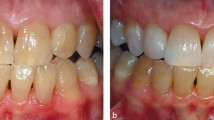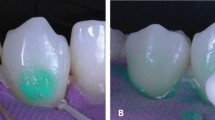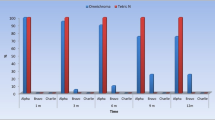Abstract
This case report describes the conservative management of generalised tetracycline stains by means of the injectable composite resin technique. This time-efficient technique obtained optimal and satisfactory aesthetic outcomes. Both the patient and the clinician were very satisfied with the results. Composite veneers realised with injected flowable resin composites are an effective treatment, with minimally invasive possibilities, providing the case selection protocol is correct. In addition, it can be considered as a more economical treatment option.
Key points
-
Describes injectable composite resin technique as an aesthetic treatment option for generalised tetracycline dental stains.
-
Highlights the advantages and disadvantages of this injectable flowable composite technique compared with other more conventional techniques.
-
Emphasises the importance of long-term monitoring of the technique due to its unknown longevity.
This is a preview of subscription content, access via your institution
Access options
Subscribe to this journal
Receive 24 print issues and online access
$259.00 per year
only $10.79 per issue
Buy this article
- Purchase on Springer Link
- Instant access to full article PDF
Prices may be subject to local taxes which are calculated during checkout











Similar content being viewed by others
References
Chopra I, Roberts M. Tetracycline Antibiotics: Mode of Action, Applications, Molecular Biology, and Epidemiology of Bacterial Resistance. Microbiol Mol Biol Rev 2001; 65: 232-260.
Bassett J, Patrick B. Restoring tetracycline-stained teeth with a conservative preparation for porcelain veneers: case presentation. Pract Proced Aesthetic Dent 2004; 16: 481-486.
Faus-Matoses V, Faus-Matoses I, Ruiz-Bell E, Faus-Llácer V J. Severe tetracycline dental discoloration: Restoration with conventional feldspathic ceramic veneers. A clinical report. J Clin Exp Dent 2017; DOI: 10.4317/jced.54359.
Shadman N, Kandi S G, Ebrahimi S F, Shoul M A. The minimum thickness of a multilayer porcelain restoration required for masking severe tooth discoloration. Dent Res J 2015; 12: 562-568.
Okuda W H. Using a modified subopaquing technique to treat highly discoloured dentition. J Am Dent Assoc 2000; 131: 945-950.
Gresnigt M M M, Cune M S, Jansen K, van der Made S A M, Özcan M. Randomized clinical trial on indirect resin composite and ceramic laminate veneers: Up to 10-year findings. J Dent 2019; 86: 102-109.
Terry D A, Powers J M. A predictable resin composite injection technique, Part I. Dent Today 2014; 33: 96-101.
Nouri R. A predictable resin composite injection technique, part 2. Dent Today 2014; 33: 12.
Ammannato R, Ferraris F, Marchesi G. The 'index technique' in worn dentition: a new and conservative approach. Int J Esthet Dent 2015; 10: 68-99.
Geštakovski D. The injectable composite resin technique: minimally invasive reconstruction of esthetics and function. Clinical case report with 2-year follow-up. Quintessence Int 2019; 50: 712-719.
Baroudi K, Rodrigues J C. Flowable Resin Composites: A Systematic Review and Clinical Considerations. J Clin Diagn Res 2015; 9: 18-24.
Shaalan O O, Abou-Auf E, El Zoghby A F. Clinical evaluation of flowable resin composite versus conventional resin composite in carious and noncarious lesions: Systematic review and meta-analysis. J Conserv Dent 2017; 20: 380-385.
Szesz A, Parreiras S, Martini E, Reis A, Loguercio A. Effect of flowable composites on the clinical performance of non-carious cervical lesions: A systematic review and meta-analysis. J Dent 2017; 65: 11-21.
Boruziniat A, Gharaee S, Sarraf Shirazi A, Majidinia S, Vatanpour M. Evaluation of the efficacy of flowable composite as lining material on microleakage of composite resin restorations: A systematic review and meta-analysis. Quintessence Int 2016; 47: 93-101.
Boeckler A, Schaller H-G, Gernhardt C R. A prospective, double-blind, randomized clinical trial of a one-step, self-etch adhesive with and without an intermediary layer of a flowable composite: a 2-year evaluation. Quintessence Int 2012; 43: 279-286.
Jordan R E, Boksman L. Conservative vital bleaching treatment of discoloured dentition. Compend Contin Educ Dent 1984; 5: 803-807.
Fradeani M. Evaluation of dentolabial parameters as part of a comprehensive esthetic analysis. Eur J Esthet Dent 2006; 1: 62-69.
Gracis S, Fradeani M, Celletti R, Bracchetti G. Biological integration of aesthetic restorations: factors influencing appearance and long-term success. Periodontol 2000 2001; 27: 29-44.
Park H-H, Lee I-B. Effect of glycerin on the surface hardness of composites after curing. J Korean Acad Conserv Dent 2011; 36: 483-489.
Gauthier M A, Stangel I, Ellis T H, Zhu X X. Oxygen inhibition in dental resins. J Dent Res 2005; 84: 725-729.
Turgut S, Bagis B. Colour stability of laminate veneers: an in vitro study. J Dent 2011; DOI: 10.1016/j.jdent.2011.11.006.
Ammannato R, Rondoni D, Ferraris F. Update on the 'index technique' in worn dentition: a no-prep restorative approach with a digital workflow. Int J Esthet Dent 2018; 13: 516-537.
Author information
Authors and Affiliations
Corresponding author
Ethics declarations
The authors declare that there are no conflicts of interest in this case report.
Rights and permissions
About this article
Cite this article
Cortés-Bretón Brinkmann, J., Albanchez-González, M., Lobato Peña, D. et al. Improvement of aesthetics in a patient with tetracycline stains using the injectable composite resin technique: case report with 24-month follow-up. Br Dent J 229, 774–778 (2020). https://doi.org/10.1038/s41415-020-2405-x
Received:
Accepted:
Published:
Issue Date:
DOI: https://doi.org/10.1038/s41415-020-2405-x



